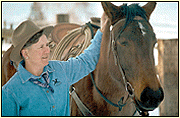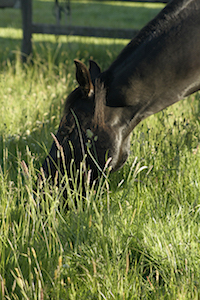Liberty Work Part 4
by Alice Trindle

In examining the suggestions within the past three articles about liberty work, I hope you have been able get out to play with your horse—no strings attached! Items that are key to your success include being mindful of why you want to accomplish liberty work for both you and the horse. This in turn sets you up to have a clear picture of what you want to accomplish with your horse, and how that will translate when you are riding. In particular, we have focused on two positions that facilitate developing this connection through body language. Now it is time to truly dance with your horse!
If any of you have seen Cavalia or watch Honza Blaha, you have a beautiful picture of what is possible if you take your liberty work to a deeper level and listen with your heart (http://vimeo.com/23825582 of Cavalia; http://youtu.be/K5ZmDkhqhW8 of Honza Blaha). Let’s get started on some exercises, dances really, to further establish the connection with your horse at liberty.
Developing the Halt Leads to Effortless Forward
Setting it Up: We will establish the halt-to-back-up-to-forward first utilizing our halter and lead, then move on to liberty. Start in a safe square pen with a horseman’s halter, 12 ft. lead, and a flag or dressage whip. After accomplishing the first step of the ‘Horseman’s Protocol’ (Breathe & Become Present) here are your next steps: Think & Picture. Think about your goal of bringing your horse to a halt and immediately to a back-up with just your body language. The idea is not to block the horse, but rather to have him clued into your picture and intentions. See yourself in a balanced posture, with rhythm, and no braces. In the beginning, while using the halter, lead, and flag, see your horse tracking up on a railroad track to the outside of the arena, and your feet flowing along the inner track. Focus. Your focus is key to the success of this exercise. Look down your railroad track, shoulders perpendicular to the horse (let’s put the horse to our right, on a square to the left, left hand is towards the center of the arena). As you walk with your horse in a square pen posture and within touching distance, hold the lead rope in your right hand and the flag in the left. Establish a flow.
Prepare for the halt-to back-up by shortening the lead so that your right hand is about one foot from the halter knot. Bring your flag into a position within your hand as if it were a sword. Pick a place ahead of you to stop and back-up parallel to the wall. As you approach this spot take a deep breath, bring your flag up parallel to the wall, and simultaneously drop your right hand on the lead rope down. At the same time, drop your seat pockets, rounding your back slightly, while saying “whoa” gently. If your horse does not stop, give him a little bump on the nose portion of the halter by bumping your right hand down towards his chest. The flag does NOT stop or back the horse. It is there as a visual reference to where the inside wall is located.
Keep your eyes down your track. Look up slightly as you drop your pockets and then level out your gaze as you get internally light, straightening your back, to ask the horse to back-up. If he does not follow your body suggestion to back-up immediately after the halt, give him another little bump on the nose with your lead rope hand. Ultimately it is NOT the bump on the halter that backs the horse, but rather your body language. As you transition from the back-up to the forward, remember to change the picture in your mind and body. Your right hand now comes forward, as if offering the horse the opportunity to follow your suggestion. Your flag might return from the sword position to being slightly behind you and inside your hand as if it was a ski pole.
Allow & Reward. It may take a couple of attempts where the horse runs into the bump of the lead rope on the halter before he eagerly seeks halt to a back-up. Be patient and vigilant about your body positioning. The reward will soon become the following of body language, effortlessly flowing forward with a verbal good job from you or even a little pet as you walk along. Once you have established this with the halter, come back the next day and try it at liberty. If your horse gets confused or becomes fractious and leaves, find the halter and set it up again.
This exercise, combined with your round pen and square pen postures will truly get you started on experimenting with all sorts of possible maneuvers with your horse. There are other maneuvers I will want to establish first with the aid of my halter, lead, snaffle bit bridle, and dressage whip to install the picture and correct positioning in both myself and the horse (Review the Work in Hand articles at: www.tnthorsemanship.com). The possibilities are endless and the relationship you create with your horse will be personal, emotional, spiritual, and brilliant!
Published August 2012 Issue

Alice was born on a ranch in eastern Oregon, the only daughter in a family of five brothers. She learned to ride behind the back of the saddle holding on to her brother’s belt loops. In the past 15 years Alice has studied with horsemen such as Tom Dorrance, Ray Hun, Dennis Reis, and Bettina Drummon. Her focus is on building a balanced relationship, applying Classical Dressage and Traditional Vaquero principles, via multi-day horsemanship retreats at her ranch in eastern OR.






